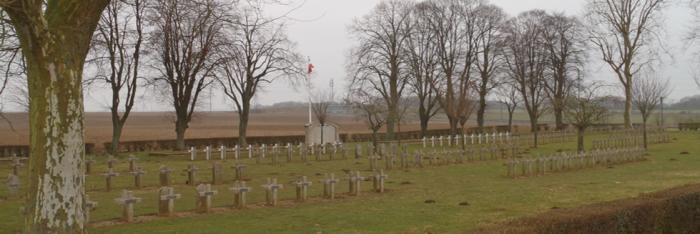
Chambry National Cemetery. Source: MINDEF/SGA/DMPA/ONACVG
Click here to view the cemetery’s information panel 
Located in the hamlet of La Pointe Fourgon, Chambry National Cemetery contains the remains of French soldiers killed in the Battle of the Ourcq, in September 1914. Established in the wake of the fighting, the cemetery was redeveloped in 1924 to hold the bodies of other soldiers killed in the battle, which were exhumed from temporary cemeteries in the area around Meaux and Coulommiers. From 1933, soldiers buried in the military burial plots of municipal cemeteries across the department were also interred here. The cemetery holds 1 334 bodies, including 364 in individual graves and 990 in four ossuaries, which is likely to include a large number of Moroccan infantrymen. There is a German military cemetery on the other side of the railway line. It was built in 1924 and comprises of 998 bodies of soldiers who fell in September 1914 around Meaux.
The Battle of the Ourcq, 5-9 September 1914
On 25 August 1914, General Joffre ordered a retreat in order to place 500 000 men in a line of resistance spanning nearly 200 miles, from Verdun to the English Channel. His objective was to cut off the Germans’ access to Paris and push them northwards. For that purpose he created the 6th Army, to defend a line from Meaux to Senlis, as there was news of enemy patrols just eight miles from Paris. In conjunction with the British, the French troops made an about-turn. The Ourcq valley then became the scene of bitter fighting, its few hills constituting crucial strategic positions.
On 25 August 1914, General Joffre ordered a retreat in order to place 500 000 men in a line of resistance spanning nearly 200 miles, from Verdun to the English Channel. His objective was to cut off the Germans’ access to Paris and push them northwards. For that purpose he created the 6th Army, to defend a line from Meaux to Senlis, as there was news of enemy patrols just eight miles from Paris. In conjunction with the British, the French troops made an about-turn. The Ourcq valley then became the scene of bitter fighting, its few hills constituting crucial strategic positions.
On 8 September, the French took a battering from the German Army. A fleet of Parisian taxis requisitioned by the French command (the “Taxis of the Marne”) enabled the front line to be maintained, in extremis, by transferring five battalions (5 to 6 000 men) there. On the 9th, the Germans, contained in Champagne, gave way on the Ourcq and, fearing being cut off from their rearguard, retreated over the Aisne, to previously fortified positions. Chambry was one of the enemy’s most advanced positions in September 1914.
From 5 to 12 September, the Battle of the Marne, and more specifically the Battle of the Ourcq, turned around what was a severely compromised military situation and halted Germany’s planned invasion of France. Paris was saved, at a cost of terrible losses: 250 000 young Frenchmen died in August and September 1914. Exhausted, the British and French armies could not find the strength to drive back the invader across its borders.
In a final thrust, each of the belligerents made a frantic dash for the sea, in order to take their enemy from behind. But it failed, and both sides were stranded on the North Sea coast. So began a conflict in the trenches that was to last four years, until the Allied victory in November 1918.